A trip through the diamond industry in March 2017
As the diamond industry marks its foray into 2017, Q1 demand for rough has been stronger relative to Q4 2016 and also relative to a year ago. Christmas season 2016, albeit mediocre, and a strong 2017 Chinese New year has driven seasonal restocking demand, and most, but not all, Indian cutters have begun to show signs of recovery after the initial shock of the demonetization last year.
Last year, most miners liquidated excess rough inventories which they accumulated in 2015, and have since ramped-up production into 2017, resuming more normal pre-indigestion output levels of three years ago.
Demand growth this year is likely to come from a post-election U.S. market where employment is stable and the stock market is at an all-time-high, driving positive sentiment that should translate into discretionary spending. The U.S. is the largest diamond jewelry market in the world representing 45% of global demand.
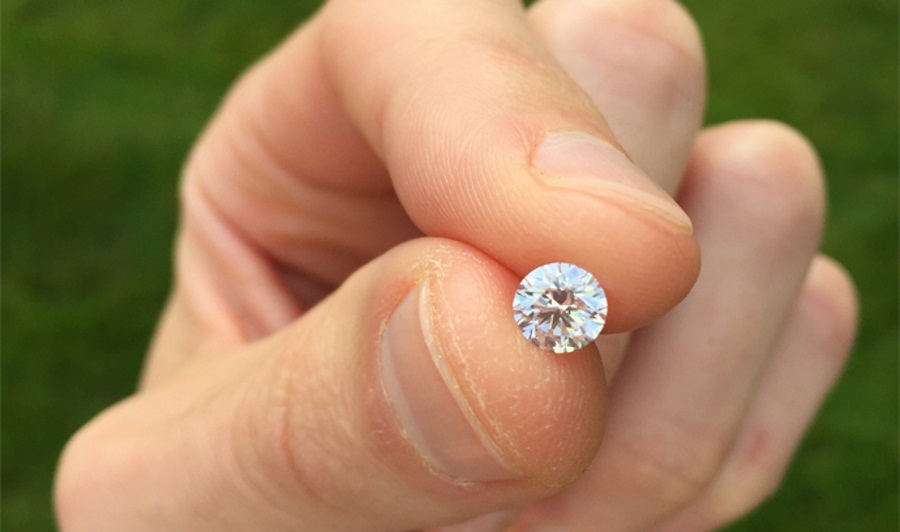
A round-cut, flawless diamond. Source: Paul Zimnisky
China, the world’s second largest jewelry market, at 16% of global demand, should be driven by continued government stimulus and an ever-expanding middle-class consumer. India, representing 8% of the market, should show improvement year-over-year as domestic demand for jewelry returns as the demonetization impact is digested, especially in the second half of the year.
Near-to-medium term risks to the industry are primarily tied to macro factors in the industry’s most important markets. For instance: the U.S. economy struggling to digest tighter monetary policy, Chinese economic deleveraging, a longer than expected recovery in the Indian market post-demonetization, signs of further disintegration of the Euro-zone, and protectionist pressure on global trade.
Year-to-date, rough diamond prices are up 0.9%, and polished prices are down 4.1%. In full-year 2016, rough and polished were both up, 13.2% and 2.1%, respectively.
Below is an outline of current industry developments, categorized by industry segment:
Upstream: The miners
De Beers (Anglo American):
A year ago, De Beers’ parent, Anglo American’s (LSE: AAL), credit default swaps were trading at a precarious level implying the company was in danger of a liquidity crisis; the stock traded at a multi-decade low. The company responded with an aggressive strategy to sell-off non-core assets, reduce debt, and restructure the company with a primary focus on diamonds, platinum and copper going forward.
Iron ore and coal prices unexpectedly surged in 2016, driven by Chinese steel production which was supported by government stimulus and tax incentives. The two commodities drove Anglo into profitability, even though they were only planned to be peripheral assets in the company’s portfolio post-restructuring.
Anglo credit default swaps normalized by the end of the year, and the stock rallied over 300% from the low in January. By year-end, the company produced $2.6B in free cash flow (operating income minus capital investment), which far exceeded the company’s February 2016 guidance of $400M (and the negative $1.0B in 2015).
In 2016, diamonds (via De Beers) contributed 23% towards Anglo’s earnings on an EBITDA (earnings before interest, tax, depreciation and amortization) basis, followed by iron ore at 22%, metallurgical coal at 16%, copper at 15%, thermal coal at 12%, and platinum at 9%.
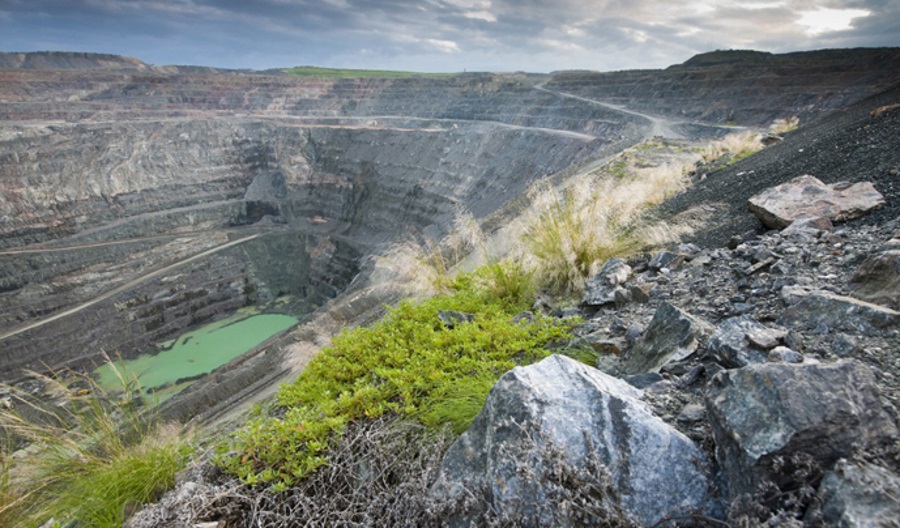
Venetia Diamond mine, South Africa. Source: De Beers Group
While iron ore and coal were the stars of Anglo’s portfolio in 2016, EBITDA from diamonds was up 42% over 2015, as rough diamond sales exceeded $5.6B (from selling 30.0M carats), which compares to $4.1B (from selling 20.0M carats) in 2015.
De Beers strong trend in diamond sales continued into 2017, as the first sale of the year, ending on January 20th, grossed $729M, making it the company’s single largest sale since mid-2014, and represented an increase of 34% over the equivalent sale in 2016, 62% over 2015, and 4% over 2014. In addition, De Beers felt that demand was strong enough to justify a 4-5% price increase in sizes greater than ¾ carats.
In the company’s second sale of the year, which ended February 20th, demand was stable but not nearly as impressive as in January, coming in at $545M, which compared to -12%, -1%, -16%, versus 2016, 2015, and 2014, respectively.
De Beers is guiding 2017 production of 31-33M carats, which on the low-end would represent a 14% increase over 2016, and on the high-end 21%. In 2016, De Beers produced 27.3M carats, which was a 5% decrease, compared to the 28.7M carats produced in 2015. The production decrease in 2016 was part of a strategy to reduce global diamond supply and allow the supply/demand balance to normalize following an industry-wide diamond stock indigestion which accumulated primarily in 2015.
The supply curtailment worked, and a pickup in demand in 2016 flushed the excess supply held by the manufacturers and retailers, and it also allowed De Beers to sell excess rough inventory held, primarily of smaller and lower-quality diamonds, in the $60-80/ct range. De Beers unloaded a total of $300M, or 4.7M carats, of excess inventory in 2016, and ended the year with a more normal inventory level of approximately $1.2B, or approximately 19M carats.
It’s worth noting that De Beers current production capacity is 35M carats, so the 2017 guidance assumes the company will produce 89-94% of capacity. De Beers has explicitly said that future production will be “subject to trading conditions.”
De Beers is currently the largest diamond producer in the world on a value basis representing approximately 40% of global diamond supply in dollars.
ALROSA:
In 2016, Russian diamond major ALROSA (RTS: ALRS), sold 40.1M carats for $4.3B, which compares to 30.0M carats sold for $3.4B in 2015.
In September 2016, the Russian government removed a 6.5% export duty on rough diamonds, but since ALROSA was subsidizing the tax for international clients, the move did not have a direct impact global diamond prices. The move does, however, incentivize ALROSA to increase production and sales since the tax savings will almost directly translate to the company’s bottom line. Russia exports 74% of rough diamond production in volume and 81% in dollar terms. ALROSA represents 95% of all Russian diamond production.

Udachny open-pit mine in Russia. Source: ALROSA Group
ALROSA has indicated that 2017 production will “remain at least flat year-over-year, or increase slightly.” The company produced 37.2M carats in 2016, eclipsing De Beers on a production volume basis by 36% (however, ALROSA’s diamonds are typically worth about 50% less than De Beers’). Despite the big number, ALROSA’s production was down 2% compared to 2015, as the company pulled back production at more flexible alluvial operations in an effort to strategically reduce global diamond supply along with De Beers following the indigestion from 2015. The company’s production capacity is approximately 41M carat, so the company is expected to produce at 91% of capacity in 2017.
During 2016, ALROSA reduced almost all excess rough inventory, approximately 2M carats, and ended the year with a normal inventory level of about 20M carats which the company has indicated as “(translated from Russian) technically the minimum level possible from a processing viewpoint.”
ALROSA is the largest diamond producer in the world on a volume basis representing almost 30% of global diamond supply in carats.
Rio Tinto:
As second largest diversified miner in the world (BHP Billiton is number one), Rio Tinto (LSE: RIO), owns and operates the largest diamond mine in the world by production volume, Argyle in Australia. The company’s only other diamond asset is a 60% stake in Canadian mine Diavik.
Both mines realized a production increase of 4% in 2016, despite indications early in the year that the company would reduce production in sympathy with De Beers and ALROSA’s plan to curtail supply until industry fundamentals improve. Production net to Rio in 2016 was 18M carats, 14M of which came from Argyle. The company recently provided a wide-ranging production guidance figure for 2017 of 19-24M carats.
Rio’s current official plans are to keep Argyle open until 2021, however the company took a $241M impairment charge on the mine last year. The impairment could be an indication that Rio may not proceed with financing the second stage of underground block cave development at the mine, which would mean only about two more years production. Rio said the impairment was a result of “lower production volumes compared with forecast, and lower prices achieved for bulk diamonds.”
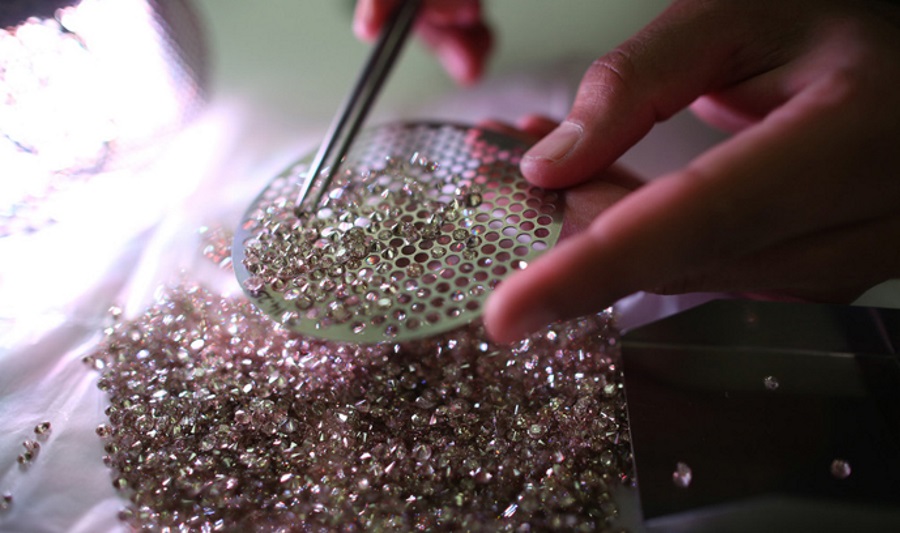
Diamond sample from Bunder project in India. Source: Rio Tinto
However, in December, Rio’s CEO Jean-Sebastien Jacques said on Bloomberg TV that diamonds are a priority area of growth for the company. But, given the company’s uncertain plans with Argyle, the gifting away of its only diamond development asset, the Bunder project in India, last month, and the selling of its 78% stake in Zimbabwe producing asset, Murowa, in 2015, Rio’s longer-term diamond plans are quite unclear.
But then again, it should be noted that politics played a primary role in Rio moving on from both Bunder and Murowa, and the Argyle decision is strictly based on economics of a mine that is at the end of its life, so these decisions are not necessarily based on Rio’s view of diamonds as a asset.
Similar to the other large diversified miners, Rio is flush with cash after a much better than expected 2016 driven by iron ore and coal, generating $5.5B in free cash flow, so maybe a diamond asset acquisition is in Rio’s future.
When Argyle closes, Rio’s only remaining diamond asset would be its 60% of Diavik. For the second largest diversified miner in the world, it wouldn’t seem to make sense for a company that thrives on economics of scale to only hold one diamond asset (let alone only a 60% stake). Making an acquisition to acquire more producing assets or selling its remaining asset and exiting diamonds all together seems more likely.
Currently, diamonds only represent 1.7% of Rio’s revenue, 1.0% of its earnings, 1.3% of its assets by book value.
Dominion Diamond Corp:
Rio’s 40% partner in Diavik and majority owner of Northwest Territory neighboring Ekati mine, Dominion Diamond (TSX, NYSE: DDC), may be an attractive acquisition target for Rio. Expansion projects at both Diavik and Eakti are planned to extend mine lives to 2023 and 2034, respectively.
Dominion has stated that internal estimates call for Diavik and Ekati to produce $1.0B and $2.9B in net free cash flow from 2018-2023 and 2018-2034, respectively. Both mines are among the richest in the world on a value-per-tonne basis because of the high concentration of diamonds in the ore, although, the average value of the diamonds is on the lower end.
In Q4 2016, Diavik diamonds sold for $112/ct and Ekati only $77/ct, which is indicative of the quality of diamonds these mines will be primarily producing going forward. Lower-quality diamonds, primarily sub-$100/ct, are currently out of favor and have been the most impacted by India’s demonetization, so there is room for improvement in the value of Dominion’s diamonds as conditions in India normalize throughout the year.
Dominion has provided production guidance of 9.1-10.0M carats for their fiscal year ending Jan 31, 2018. In the 12-months ending Jan 31, 2017 Dominion produced 7.9M carats, a challenging year for the company as the Ekati mine was disrupted by a processing plant fire that resulted in approximately 1M carats of lost production.
The company held $198M in cash as last reported, has no debt, and has the potential to generate significant free cash flow in 2017 (in the $150M range), even with diamond prices at current levels. Dominion has confirmed it will pay a regular dividend of at least $0.40/sh in 2017, which currently yields 4.7%.
Petra Diamonds:
Petra Diamonds (LSE: PDL), the London-listed, South African producer that owns and operates a portfolio of 5 ex-De Beers mines is guiding to grow production from current level of 4.5M carats to 5.3M carats by 2019 as it produces higher-quality ore from its Cullinan and Finsch mine expansion projects.
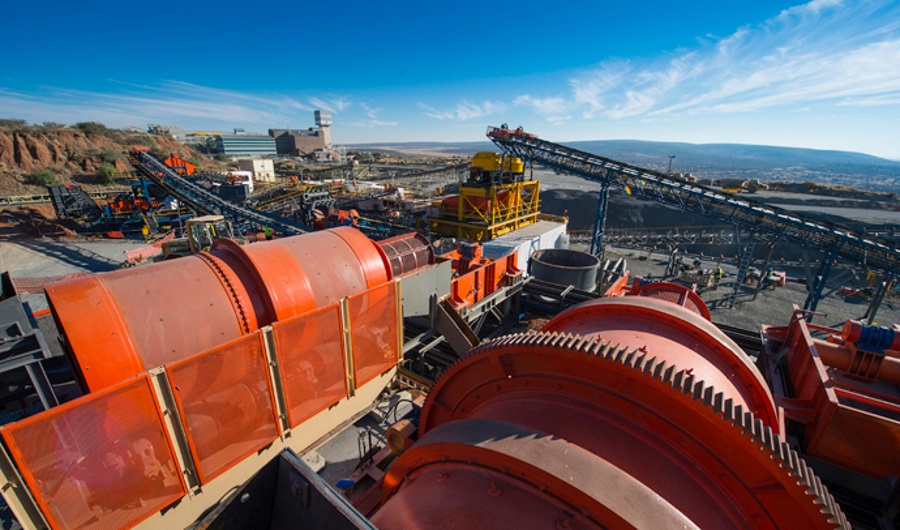
Plant at Finsch mine in South Africa. Source: Petra Diamonds
Petra’s inventory has remained relatively stable for the last 3 years at $45-55M as the company did not participate in supply reduction post-indigestion as did De Beers and ALROSA. Petra expects to be free cash flow positive by mid-2017 as production ramps up and cash allocated towards the expansion projects declines.
The company has said that it is considering reinstating a dividend and will make a decision by mid-year.
Lucara Diamond Corp:
Lucara (TSX: LUC), the single-asset producer, but owner of the world-class Karowe mine in Botswana, has guided to produce 290-315k carats in 2017, which compares to 354M carats in 2016. In 2017, the company will continue to mine the rich South Lobe portion of the Karowe ore body, which is known to produce exceptional diamonds such as the Lesedi La Rona, the second-largest rough gem-diamond ever produced, which was uncovered by Lucara in 2015.
After failing to meet the reserve price with a high bid of $61M at a Sotheby’s auction last summer, the Lesedi La Rona is expected to be sold through private channels in 2017. A selling price of less than $70M would be a disappointment, a price close to or above $100M would be an upside surprise. With 382M shares outstanding, a $100M sale would equate to $0.26/share. The current stock price is $2.10 (C$2.78) and has a dividend yield of 3.6%.
Gem Diamonds:
Gem Diamonds (LSE: GEMD) currently operates only one mine, Letšeng in Lesotho, but it produces some of the highest quality diamonds in the world. In 2016, the mine produced 108k diamonds that averaged $1,695/ct. However, last year Letšeng saw a decrease in notable stones recovered, as it only produced 2 diamonds that were both >100ct and >$10k/ct, compared to 7 in both 2015 and 2014.
Of note, the company also owns the Ghaghoo mine in Botswana, which produced 41k carats in 2016, worth an average of $142/ct. However, the company put the mine on care and maintenance last month as the recent diamond price achieved does not make the mine economically viable, and the company believes that the “(market) prices for this category of diamonds may remain constrained.”
Endiama:
The Angolan state-run diamond miner, Endiama, produced 9M carats at $119/ct in 2016, versus 8M carats at ~$150/ct in prior years. The company said it would “slightly” curtail production in 2017 to help support global prices, until its new world-class mine, Luaxe (also referred to as Luachi), goes into production, which could be as early as next year.
Currently the Catoca mine represents the company’s largest share of production, at about 75%, but according to unofficial communication from Endiama, the Luaxe project has the potential to produce almost 12M carats annually, which would be almost double what Catoca is currently producing.
ALROSA is partnered with Endiama on the Catoca mine, and also the Luaxe project.
Zimbabwe Consolidated Diamond Company:
Production at the Marange alluvial diamond fields in eastern Zimbabwe, with a soiled history of civil rights abuse, and illegal production and trade, was likely to be less than 2 million carats in 2016, and is expected to fall even further in 2017.
Last year the government nationalized diamond mining under the moniker, Zimbabwe Consolidated Diamond Company, revoking mining licenses from a handful of private companies, primarily Chinese. Since, the government has failed to effectively take on operations independently, especially as the alluvial mines reach economic depletion.
The mines produced as much as an estimated 17M carats, albeit very low-quality diamonds, as recently as 4 years ago.
Synthetics:
Lab-created diamond production technology continues to improve as capital is being invested in improving product quality and production economics. Participation is global as manufacturers from California, to St. Petersburg, to Singapore see opportunity in advancing synthetic diamond technology.
U.S. based Diamond Foundry (private) is focused on the jewelry market, while Russia’s New Diamond Technology (private) is only using the jewelry market as a stepping stone, as its sees high-tech application as the most lucrative channel for lab-created diamonds.
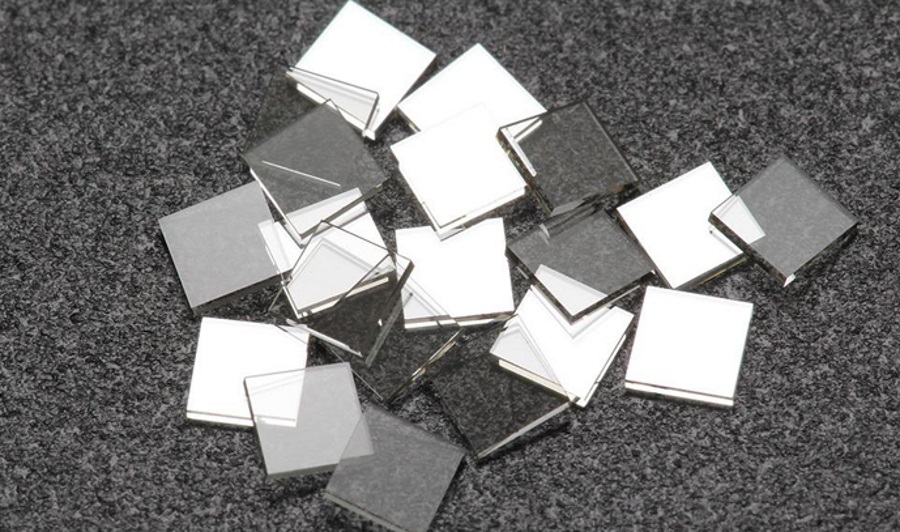
Lab-created diamond plates for high-tech application. Source: New Diamond Technology
Monthly lab-created production, fabricated to be sold as jewelry, is only in the tens-of-thousands-of-carats range, compared to mined natural diamond production, which is in the 10-11M carats/month range.
Most synthetics are being sold directly from the manufactures, or on “memo,” or consignment, at jewelers. The lack of motivation for jewelers (selling on consignment) to push product is limiting product awareness, and new customers opportunities. The current environment is indicative of the significant investment in branding, advertising, and distribution necessary for synthetics to effectively penetrate the jewelry industry.
In 2016, industrial-application synthetic diamond demand was hurt by a depressed global oil and gas industry. Most, over 90%, of industrial grade diamonds are provided by synthetic production, mostly in China and India. The balance comes as a by-product of mine production.
ALROSA’s industrial-grade diamonds are currently selling for $6/ct compared to $7-8/ct a year ago. However, a recent uptick in oil prices, as OPEC implements a new supply curtailment program, should incentivize year-over-year growth in oil and gas drilling and equipment that utilize diamonds as abrasives.
Midstream: The manufacturers
Early-2016 diamond manufacturer restocking demand, after a stronger than expected 2015 holiday season, combined with De Beers’ and ALROSA’s production curtailment, alleviated most of the industry-wide inventory indigestion by the second half of 2016.
However, just as diamond supply/demand dynamics were beginning to normalize, India’s surprise demonetization in November threw another blow at the already recovering industry. Over 90% of diamonds, by volume, are cut in India, a business that is heavily reliant on cash transactions. In addition, India has become the third largest end-consumer of diamond jewelry in the world, at 8% of global demand, so the restriction also impacted domestic jewelry consumption as most Indian consumers are accustom to cash purchases.
The implication has primarily been felt on lower-quality rough diamonds, those that sell for less than $100/ct, produced at mines like Rio Tinto’s Argyle, Dominion’s Ekati, Petra’s Finsch, ALROSA’s Aikhal, and alluvial operations around the world. Demand for these stones are typically driven by the hundreds of small, independent, cash-reliant Indian manufactures, which buy on the secondary market; a lot of stones in this category eventually end up being purchased domestically by Indian jewelry consumers.
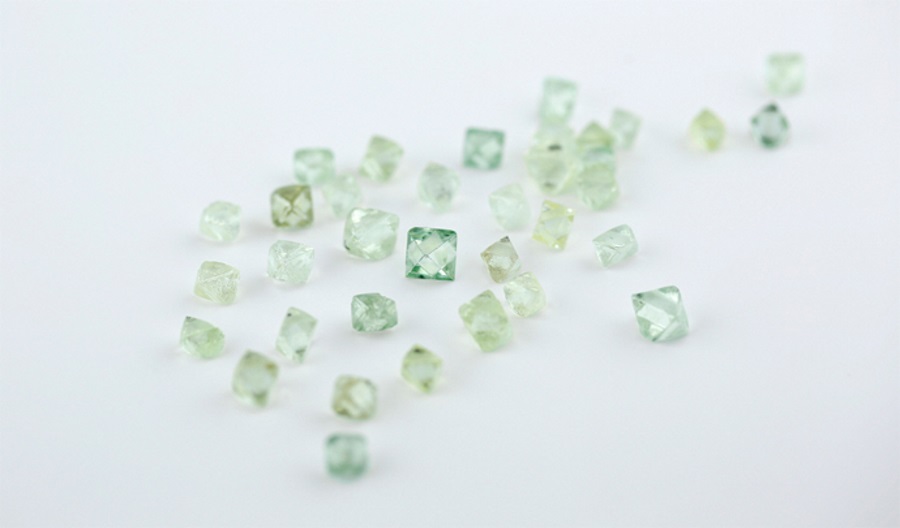
Rough diamonds from the Grib mine in Russia. Source: Grib Diamonds
The larger manufacturers have been much less affected by the demonetization, as they have a global presence, more structured businesses, adhere to more formal accounting measures, and are not reliant on cash for their Indian business.
Most of the smaller and medium sized Indian business that will survive are expected to have integrated more-transparent, digital payment processes by the second half of the year. The result will be a pickup in demand for lower priced rough, as the these manufacturers bid to restock, competing to fill a pending shortage of smaller, lower-quality polished in the market that will be felt around Q2 2017.
Downstream: The retailers
Tiffany & Co.:
Full year 2016 results from Tiffany (NYSE: TIF) will not be out until mid-March, but will likely show net sales and SSS (same-store-sales) down low-single digits. The company’s largest market, the U.S., representing 40% of business, was challenged by a stronger dollar, which had a negative impact on tourism spending, particularly impacting Chinese and European travelers to the U.S.
Domestic consumption in the U.S. was relatively stable, however, uncertainty surrounding the November election had a minor impact on consumer spending, and post-election protesting outside of the company’s flagship location in New York, which is adjacent to the Trump Building, notably impacted sales.
Japan, representing 18% of Tiffany’s business, was the company’s best performing region on a SSS basis through November 2016. Japanese growth was driven by domestic consumption, however, a stronger yen has deterred Chinese tourism spending in the country. Mainland China, South Korea, and the U.K. were also notable positive markets for the company, in addition, Hong Kong showed a decelerating sales decline. Europe, ex-UK, especially France, Australia, and Singapore were marginally weaker.
The company recently noted strength in its fashion jewelry products, which is typically lower priced “non-fine” jewelry.
Signet Jewelers:
Signet (NYSE: SIG), parent of Kay Jewelers and Zales brands, is the U.S.’s largest jeweler. The company’s fiscal Q4, which runs from November through January, and typically accounts for half of the company’s annual profit, showed a SSS decline of 5% through mid-January.

Kay Jewelers store in New Jersey, USA. Source: Paul Zimnisky
The company attributed the weakness to underperformance online, as their website was unable to effectively handle considerable growth in web-consumer traffic. Web currently accounts for approximately 5-6% of the company’s sales.
Performance was also impacted by lower mall traffic, however off-mall (standalone stores and outdoor malls) outperformed. Regional weakness in oil and gas reliant areas, such as Texas, North Dakota, and Alberta, Canada was also noted.
Similar to Tiffany, Signet recently noted strength in lower-priced fashion jewelry lines, but also noted strength in branded diamond jewelry.
Chow Tai Fook:
Greater China proxy, Chow Tai Fook (HK: 1929), showed positive same store sales growth in Q4 2016 for the first time in 6 quarters. Over the last year-and-a-half, the company has attributed weakness to consumer sentiment and high SSS comparable figures, but recently noted “stabilizing industry fundamentals and margin improvement.”
Mainland China has been less-weak than Hong Kong and Macau for the company, and they continue to open net-new stores in Mainland, and continue to close net-stores in Hong Kong and Macau. Currently, Mainland represents 55% of the company’s revenue.
The percentage of the company’s revenue from gem-set jewelry has been increasing over the last 5 years, from 22-27%, and revenue from gold has been slightly decreasing from 56-54% over the same time frame. Although, recent performance has been driven by gold sales, as the metal has been less expensive, down about 12% in Q4, 2016.
—
At the time of writing Paul Zimnisky held a long position in Dominion Diamond Corp.
Paul Zimnisky is an independent diamond industry analyst and consultant. He can be reached at www.paulzimnisky.com, and followed on Twitter @paulzimnisky.
{{ commodity.name }}
{{ post.title }}
{{ post.date }}

Comments